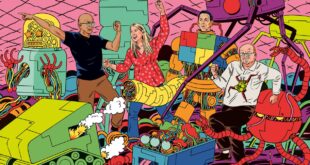This developing field, known as aerial electroreception, opens up a new dimension of the natural world. “I find it absolutely fascinating,” said Anna Dornhaus, a behavioral ecologist at the University of Arizona who was not involved with the work. “This whole field, studying electrostatic interactions between living animals, has the potential to uncover things that didn’t occur to us about how the world works.”
“We know from all these brilliant experiments that electric fields do have a functional role in the ecology of these animals,” said Benito Wainwright, an evolutionary ecologist at the University of St. Andrews who has studied the sensory systems of butterflies and katydids. “That’s not to say that they came on the scene originally through adaptive processes.” But now that these forces are present, evolution can act on them. Though we cannot sense these electric trails, they may guide us to animal behaviors we never imagined.
Electrostatic Discoveries
In 2012, Víctor Ortega-Jiménez stumbled into electrostatics while playing with his 4-year-old daughter. They were using a toy wand that gathers static charge to levitate lightweight objects, such as a balloon. When they decided to test it outside, he made a startling observation.
PICTURE
Caption: Studies by Víctor Ortega-Jiménez of the University of California, Berkeley, revealed that a negatively charged spiderweb attracts positively charged insect prey.
Credit: Courtesy of Víctor Ortega-Jiménez
“My daughter put the wand close to a spiderweb, and it reacted very quickly,” recalled Ortega-Jiménez, who studies the biomechanics of animal travel at the University of California, Berkeley. The wand attracted the web. He immediately began to draw connections to his research about the strange ways insects interact with their environments.
All matter—wands, balloons, webs, air—strives for balance between its positive and negative particles (protons, electrons and ions). At an unfathomably small scale, Ortega-Jiménez’s toy buzzes with an imbalance: A motor draws negative charges inward, forcing positive charges to the wand’s surface. This is static. It’s like when you rub a balloon against your head. Friction sheds electrons from your hair to the rubber, loading it up with static charge, so that when you lift the balloon, strands of hair float with it.
In a similar way, Ortega-Jiménez considered, friction from beating insect wings could shed negative charges from body to air, leaving the insects with a positive charge while creating regions of negative static. He realized that if a web carries negative charge and insects a positive one, then a spiderweb might not just be a passive trap—it could move toward and attract its quarry electrostatically. His lab experiments revealed precisely that. Webs deformed instantly when jolted with static from flies, aphids, honeybees, and even water droplets. Spiders caught charged insects more easily. He saw how static electricity altered the physics of animal interactions.
Source link
 meganwoolsey Home
meganwoolsey Home



